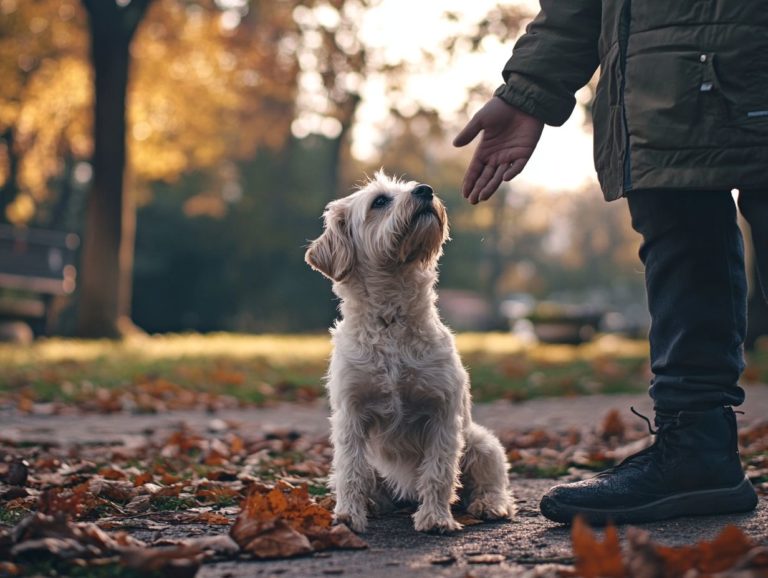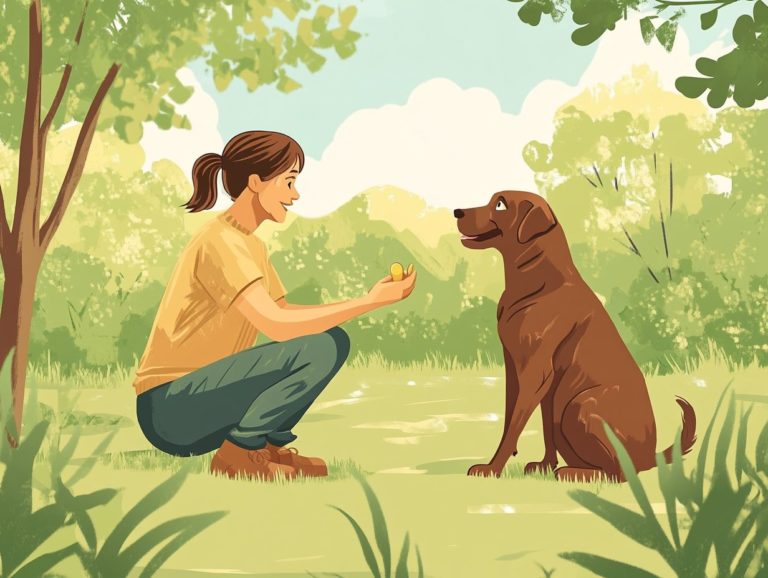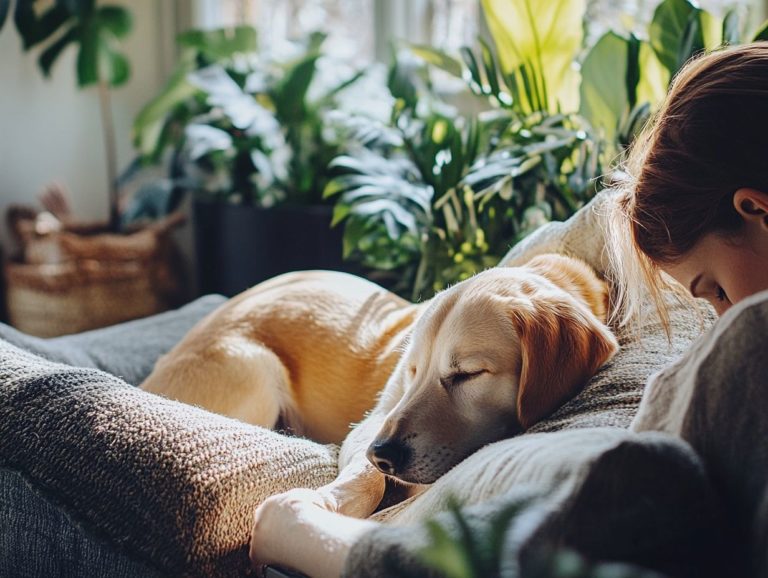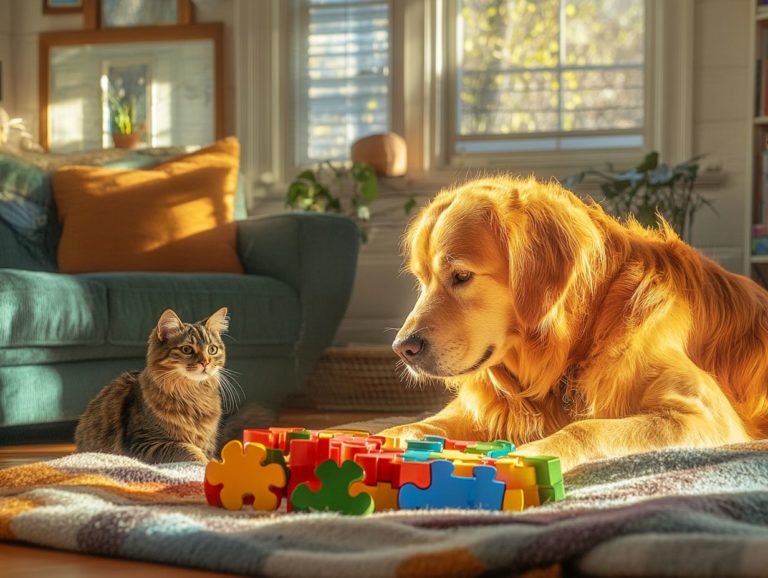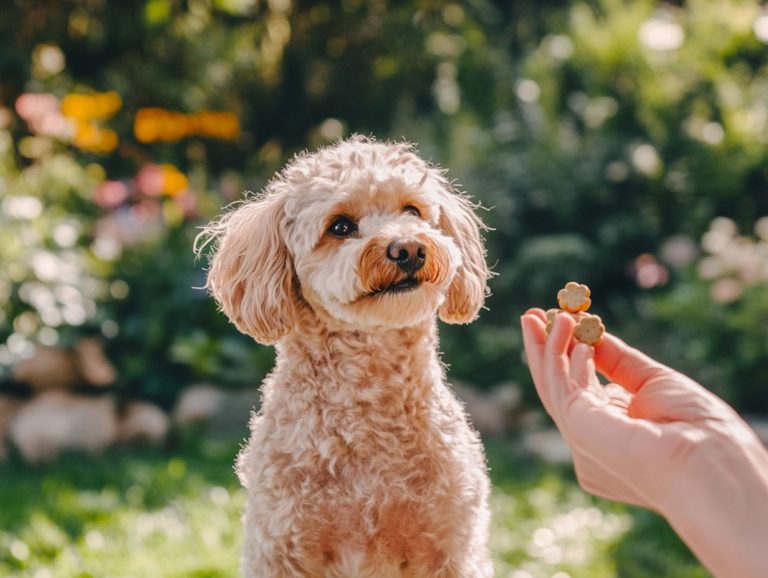Understanding Positive Reinforcement for Anxious Pets
Navigating the world of pet anxiety can be quite the challenge for both you and your furry companion.
Get ready to dive into the essentials of positive reinforcement! This compassionate approach helps anxious animals feel more secure and confident. In this article, we’ll explore the fundamentals of positive reinforcement and its significance in managing anxiety.
You ll uncover practical steps for implementing these techniques, common pitfalls to avoid, and alternative methods to consider. Together, let s explore how to create a nurturing environment that supports your anxious pet.
Contents
- Key Takeaways:
- What is Positive Reinforcement?
- How Positive Reinforcement Can Help Anxious Pets
- Implementing Positive Reinforcement Techniques
- Common Mistakes to Avoid
- Alternative Methods for Anxious Pets
- Frequently Asked Questions
- What is positive reinforcement for anxious pets?
- How does positive reinforcement help anxious pets?
- What are some examples of positive reinforcement for anxious pets, including training sessions and clicker training?
- Is positive reinforcement the same as bribery for anxious pets?
- Can positive reinforcement be used alone to treat anxiety in pets?
- Is positive reinforcement suitable for all types of anxious pets?
Key Takeaways:

- Positive reinforcement rewards good behaviors, making them more likely to happen again. It’s effective for managing pet anxiety.
- This method builds confidence and lowers stress in pets, improving their overall behavior and the bond with you.
- To use positive reinforcement, identify what behavior you want, choose a reward, and consistently reinforce that behavior. Avoid mistakes like using punishment or being inconsistent.
What is Positive Reinforcement?
Positive reinforcement is a powerful dog training technique that encourages desirable behaviors through rewards. This method nurtures a trusting bond between you and your dog. It’s based on a method where good behavior is rewarded to encourage it, creating a training environment ripe for growth and understanding.
By using various training techniques like verbal praise and tasty treats you can effectively shape your dog’s behavior. This approach fosters a calm atmosphere, promotes confidence, and alleviates anxiety.
Definition and Basic Principles
Positive reinforcement involves rewarding your dog for displaying desired behaviors. This significantly increases the likelihood that those behaviors will be repeated during training.
In contrast, negative reinforcement means removing an unpleasant stimulus to encourage specific behavior. While both strategies aim to shape behavior, positive reinforcement focuses on adding something enjoyable like treats or praise to create a positive experience for your dog. Utilizing these rewards cultivates a trusting bond that enhances the overall learning experience.
Understanding these principles not only facilitates effective dog training but also ensures the journey is rewarding and engaging for both you and your canine companion.
How Positive Reinforcement Can Help Anxious Pets
Positive reinforcement plays a crucial role in managing dog anxiety by fostering positive associations and encouraging calming signals that anxious dogs need for comfort and security during stressful moments.
By rewarding desired behaviors like remaining calm amidst loud noises or unfamiliar settings you create a safe and trusting environment where your dog feels genuinely at ease.
This approach reduces fear responses and strengthens the bond between you and your furry companion.
Benefits for Anxiety Management
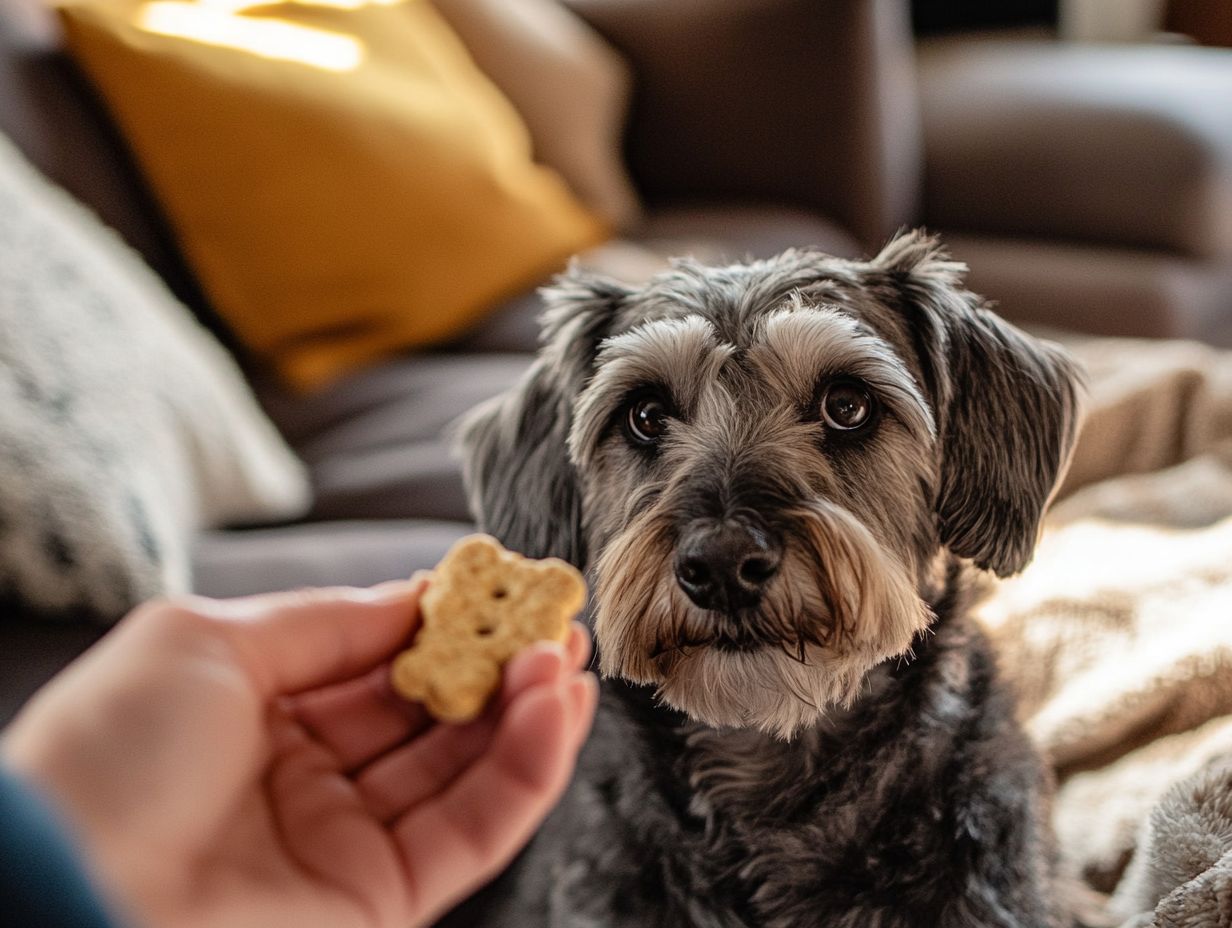
Implementing positive reinforcement in dog training presents a myriad of benefits for managing anxiety, including effective behavior reinforcement and desensitization techniques. Additionally, using aromatherapy to calm anxious pets can help dogs gradually acclimate to their fears.
By emphasizing rewards for calm behavior instead of punishing anxious responses, you build a trusting relationship with your dog. This significantly reduces stress.
For example, when exposed to things that make your dog anxious, offering treats or praise can encourage your dog to remain relaxed. Utilizing tools like clickers small devices that make a sound to mark the behavior you want to reward can enhance this process, providing a clear signal that the desired behavior has been acknowledged.
Resources such as training classes or training resources can guide you in employing techniques like gradual exposure or counter-conditioning. Imagine slowly introducing your dog to the sounds of thunderstorms while pairing those noises with positive experiences, ultimately fostering a more confident companion.
Implementing Positive Reinforcement Techniques
Implementing positive reinforcement techniques in dog training demands a structured approach. This allows you to effectively encourage desired behaviors through a comprehensive, step-by-step guide that weaves in various training techniques during each session.
This method strengthens the bond between you and your dog while fostering a trusting relationship based on rewards and positive experiences.
Step-by-Step Guide
A step-by-step guide for implementing positive reinforcement in dog training begins with a solid understanding of the training process. Consider using tools like a clicker to effectively mark the behaviors you want to encourage.
To ensure successful behavior reinforcement, identify the specific behavior you wish to promote. It s important that this behavior is clear and achievable.
Once you have that in mind, reward your dog immediately after the desired behavior occurs; this precise timing helps your dog make a strong connection between the action and the reward.
Consistency is your best friend here. Reinforcing behaviors consistently whether with treats, praise, or playtime will solidify the learning process.
As you progress, vary the rewards while keeping the same high standard of reinforcement. This not only strengthens the training but also fosters trust, making the experience enjoyable for both you and your dog.
Common Mistakes to Avoid
When you engage in positive reinforcement during dog training, it s essential to steer clear of common mistakes that could undermine your efforts. Avoid these common mistakes to ensure your training sessions are fun and effective for both you and your furry friend!
Recognizing these pitfalls is key to ensuring that the training experience remains effective and enjoyable for both you and your beloved companion.
Potential Pitfalls and How to Overcome Them
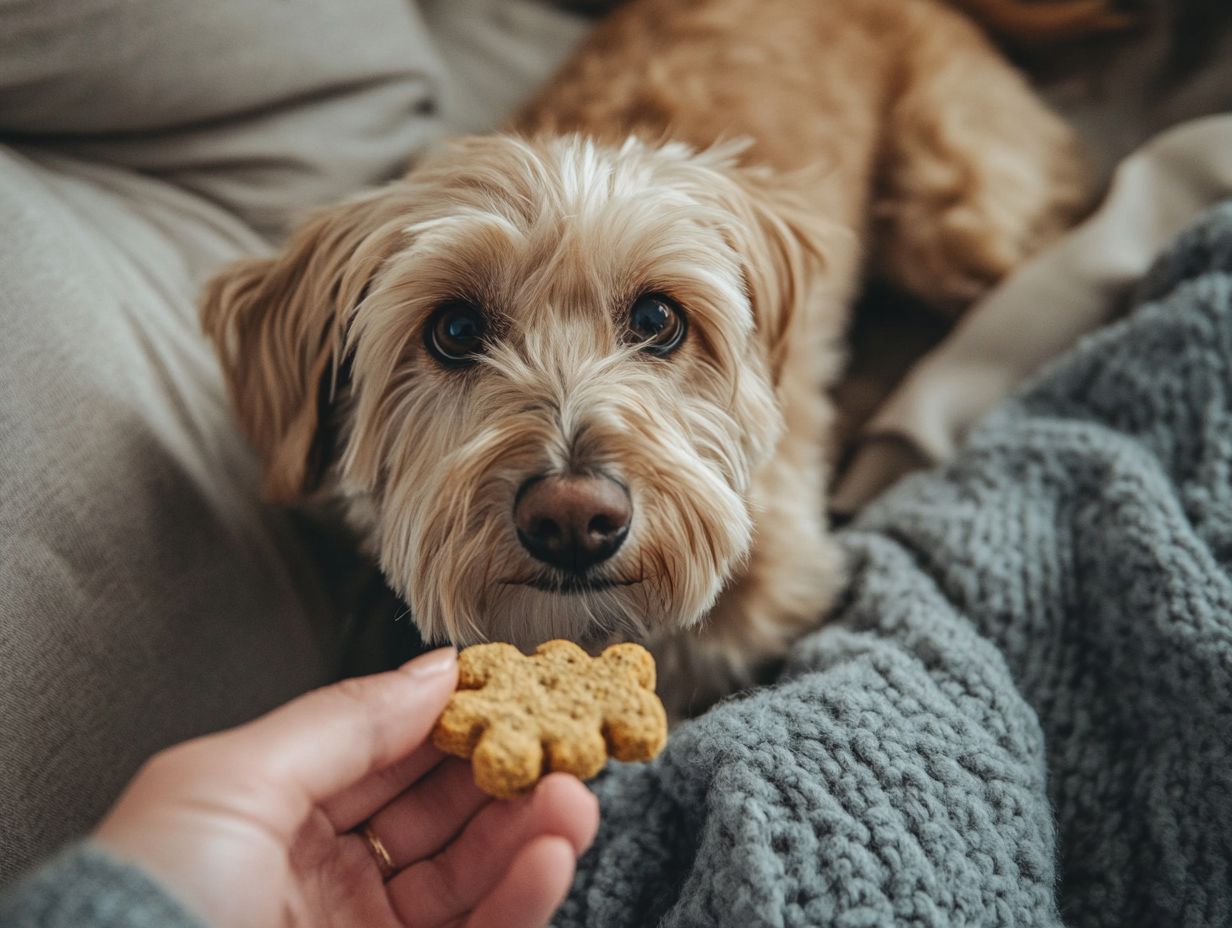
Potential pitfalls in positive reinforcement training can arise from inconsistent rewards or poor timing, which may leave your dog confused and hinder effective behavior reinforcement.
These challenges often lead to frustration for both you and your dog, as your pet struggles to grasp what s expected of them.
To overcome these hurdles, it s essential for you to establish a clear set of criteria for which behaviors will be rewarded and to adhere to that plan in every training session.
By ensuring that your reward system is both consistent and timely delivering the reward immediately after the desired action you can help your dog understand the concepts being taught.
This clarity not only fosters trust but also enriches the bond between you and your dog, laying a solid foundation for future learning.
Alternative Methods for Anxious Pets
While positive reinforcement stands out as a highly effective training method for anxious pets, don’t overlook other techniques! For instance, consider using music to calm anxious pets during training, along with alternatives like negative reinforcement and various desensitization techniques, which can also prove beneficial in certain situations.
These methods can be particularly effective when paired with a keen understanding of calming signals, allowing you to create a more comprehensive and tailored training experience for your pet.
Exploring Other Training Approaches
Exploring alternative training methods, like negative reinforcement, can equip you with additional tools for managing anxious dogs. This is especially true when combined with techniques for recognizing and responding to calming signals. Such approaches foster a deeper understanding of canine behavior.
For example, some trainers have discovered that gradually getting dogs used to their fears, whether it s loud noises or unfamiliar environments, can be effective. On the other hand, counter-conditioning can shift a dog s negative associations with certain stimuli into positive experiences. Both methods can work in harmony with positive reinforcement. Rewarding a dog for remaining calm in previously stressful situations reinforces the desired behaviors.
By integrating these complementary strategies, you can craft a balanced approach tailored to meet each dog s unique needs.
Frequently Asked Questions
What is positive reinforcement for anxious pets?
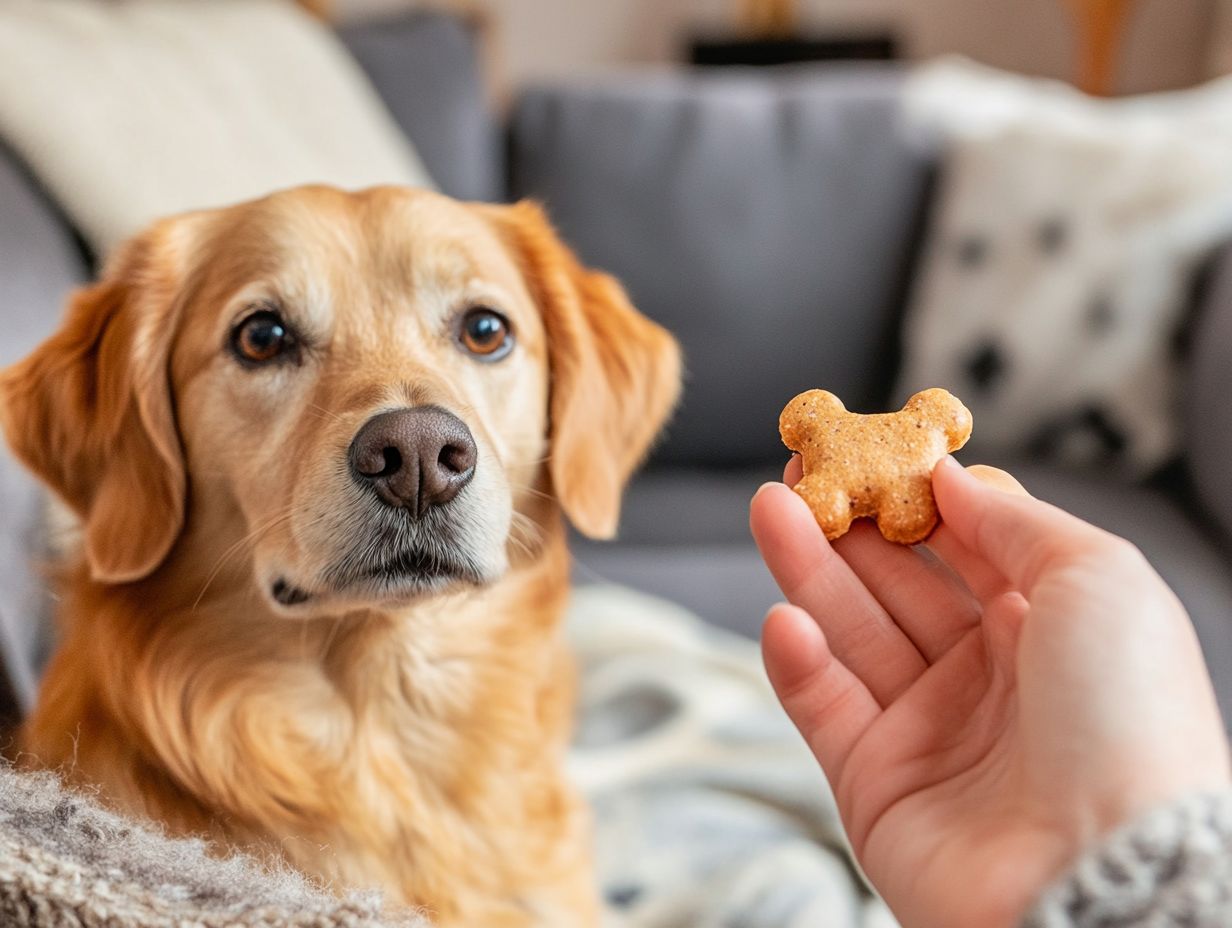
Positive reinforcement for anxious pets is a training technique that rewards desired behaviors with treats, praise, or other rewarding forms. This approach encourages and rewards good behavior instead of punishing bad behavior. For more insights, consider understanding the needs of anxious pets.
How does positive reinforcement help anxious pets?
Positive reinforcement helps anxious pets, including dogs and puppies, by creating a positive association with certain behaviors or situations that may trigger their anxiety. Additionally, using scent training to calm anxious pets can also enhance their comfort and confidence, leading to better behavior and reduced anxiety.
What are some examples of positive reinforcement for anxious pets, including training sessions and clicker training?
Examples include giving treats, praise, or attention when they display calm behavior. You can also use toys or games to distract them from anxiety triggers and create a calm environment where they feel secure. Techniques like gradually getting a pet used to their fears can also be beneficial.
Is positive reinforcement the same as bribery for anxious pets?
No, positive reinforcement is not the same as bribery. Bribery involves giving something in exchange for a desired behavior, while positive reinforcement rewards good behavior that has already been exhibited. This approach focuses on building a positive relationship and trust with your pet, rather than manipulating them into behaving a certain way.
Can positive reinforcement be used alone to treat anxiety in pets?
Positive reinforcement is a useful tool in managing anxiety in pets, but it shouldn’t be the only method used. It’s important to address the root cause of the anxiety and seek professional help if needed. Training classes and guidance from pet parents can enhance reinforcement, making it a helpful supplement to other treatments and techniques for anxiety.
Is positive reinforcement suitable for all types of anxious pets?
Yes, positive reinforcement can be used for all types of anxious pets, including dogs, cats, and small animals. However, it’s important to tailor the approach to the individual pet’s needs and personality. For example, using clicker training to alleviate anxiety can be effective, as some pets may respond better to certain forms of positive reinforcement, such as gentle training or desensitization to loud noises.
Have you tried these techniques with your pet?

